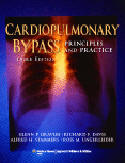SECTION 1:HISTORY
Historical Development of Cardiopulmonary Bypass in Minnesota
The Birth of an Idea and the Development of Cardiopulmonary Bypass
SECTION II EQUIPMENT
Blood Pumps in Cardiopulmonary Bypass
Principles of Oxygenator Function: Gas Exchange, Heat transfer, and Operation
Circuitry and Cannulation Techniques
Ultrafiltration and Dialysis
Mechanical Circulatory Support Devices
Cardiopulmonary Bypass for Minimally Invasive Cardiac Surgery
SECTION III:PHYSIOLOGY AND PATHOLOGY
Temperature Management in Cardiac Surgery
Myocardial Protection
Changes in the Pharmacokinetics and Pharmacodynamics of Drugs Administered During Cardiopulmonary Bypass
Embolic Events
Endocrine, Metabolic, and Electrolyte Responses
Cardiopulmonary Bypass and the Lung
Immune System and Inflammatory Responses to Cardiopulmonary Bypass
Kidney Function and Cardiopulmonary Bypass
Splanchnic Visceral, Metabolic, and Glucoregulatory Effects of Cardiopulmonary Bypass
Neurologic Effects of Cardiopulmonary Bypass
SECTIION IV. HEMATOLOGY
Hemodilution and Priming Solutions
The Blood-Surface Interface
Hematologic Effects and Coagulopathy
Coagulation Testing
Anticoagulation
Heparin Neutralization
Pharmacologic Prophylaxis Against Post-Cardiopulmonary Bypass Coagulopathy
SECTIN V: CLINICAL APPLICATIONS
Conduct of Cardiopulmonary Bypass
Teamwork: A Systems-Based Practice
Primum Non Nocere: Patient Safety in Cardiopulmonary Bypass
Unusual Problems in Cardiopulmonary Bypass
Termination of Cardiopulmonary Bypass
ECMO for Respiratory Support in Adults
Perfusion for Thoracic Aortic Surgery
Noncardiac Surgical Applications of Cardiopulmonary Bypass
SECTION VI. NEONATES, INFANTS, AND CHILDREN
Pediatric Cardiopulmonary Bypass Overview:State of the Art and Future
Myocardial Protection and Preservation for Neonates and Infants
Brain Injury Following Infant Cardiac Surgery and Neuroprotective Strategies
ECMO for Infants and Children
Circulatory Assist Devices for Infants and Children
INDEX


